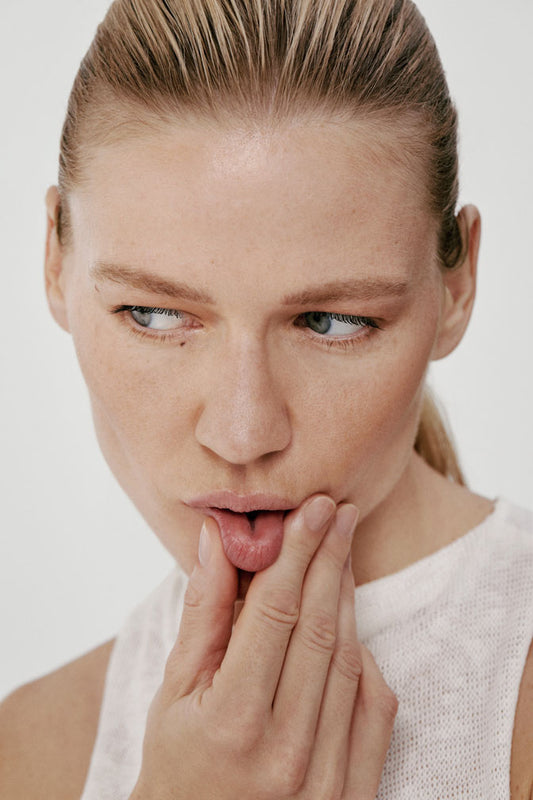| It is said that you never stop knowing yourself. Over the years, you have learned to see what you want and don't want. So why not do the same with your body? Knowing how to treat (and pamper) your skin at every age is essential—at 30, at 40, and not just when the changes in our skin are more noticeable, such as adolescence or menopause, but also in between. Each decade has its changes and needs. Now, we need to determine which ones. |
Inside and out - how your skin changesDr Anjali Mahto is one of the UK's leading dermatologists. Her book The Skin Care Bible states, "the external process of ageing is felt in the skin before any other organ. The changes are visible to us and those around us, and unlike many other medical problems, we cannot hide the fact that we are getting older." We cannot avoid intrinsic factors because they come from within us, such as hormonal changes, especially in women. In this case, "women are more vulnerable than men because of the more complex hormonal patterns that occur not only during our menstrual cycles but throughout our lives in general," says the doctor in her guide. However, there are others, such as stress, which is the natural defence mechanism your body has to face any risky or threatening situation. Stress is not only a psychological or emotional state but can also affect you physically with symptoms as varied as itching, redness, hives, or dermatitis, among others. However, extrinsic factors could be avoided (or at least prevented). But how?
|
Understand your skin's needs in your 30sAs we age, the number and size of skin cells decrease. In fact, from age 20, collagen production in the skin decreases by 1% per year. |
 |
How (and why) does skin change in your 30s?Dry skin, changes in pigmentation - especially if we have previously abused our skin in the sun - and hyperpigmentation, loss of elasticity - as collagen and elastin fibres are reduced - and the appearance (or increase) of expression lines and wrinkles are some of the changes your skin will begin to notice as the decade progresses. However, "the changes depend very much on the type of skin we have and how we have cared for it. It is clear that age has something to do with it, but it is not the only factor," points out Yaiza Bouzas, an expert in dermopharmacy and cosmetic formulation, as well as clinical nutrition and skin microbiota. How to look after your skin in your 30s"As with any cosmetic routine, there are a few fixed steps such as cleansing, moisturising and sun protection," explains Yaiza Bouzas. At this age, the skin starts to lose moisture, so it is essential to include products that help retain water in the skin, such as cleansers and moisturisers, although it all depends on your skin type. |
OBJECTIVE: HYDRATIONAccording to the dermo-pharmacy expert, skin dryness is one of the first changes the skin undergoes at 30. The best way to combat this is to incorporate moisturisers into your skincare routine, from cleansing to make-up. |
|
In addition to deep cleansing, the MULTIACTIVE SERUM CLEANSER contains plant squalane to help protect the skin barrier, improve skin elasticity and prevent moisture loss. If you moisturise your skin, why not do the same for your lips? The skin on the lips is thinner and more delicate. Hyaluronic acid and retinol are the winning combination to protect them. The former is the moisturising active ingredient par excellence, and the latter is the most popular anti-ageing component. This is an ideal mix to regenerate, smooth, and improve the elasticity of your lips, as well as prevent wrinkles and expression lines, which are frequent around the mouth.
|
 |
Understand your skin's needs in your 40sTime cannot be stopped. As the years pass, wrinkles, furrows, expression lines, and blemishes become more common. However, Bouzas says there doesn't have to be such a big difference between decades "if we take care of our skin and follow a simple but effective routine". Genetics also play a fundamental role. "If your parents aged well, chances are you will too," says Dr Anjali Mahto in her book. However, it is essential to remember that as we age, "collagen and elastin fibres and lipids decrease, so the extracellular matrix of our skin tends to become more wrinkled and drier. The skin becomes thinner, dehydrated, dull or lacks radiance, in addition to other signs such as sagging or lack of firmness and the presence of blemishes. |
How to look after your skin in your 40sTaking this into account, at 40 it is necessary, in addition to moisturizing, to include (or increase) active ingredients in your facial routine to counteract the effects of skin oxidation such as vitamins C and E, retinoids, resveratrol, niacinamide... Exfoliation is another action to include in your skincare, since at this age dead cells come off less easily. |
 |
 |
|
How to prevent or reduce skin oxidation and the dreaded spots? With antioxidant principles such as vitamin C, which prevents damage caused by free radicals. A fundamental asset after 40, from creams and serums, to makeup products such as foundations and concealers. And blemishes?They tend to increase after age 40, "especially if we have abused the sun in previous years. The most common areas are usually the cheeks and forehead, commonly known as the 'melasma mask'," says the expert in dermo pharmacy and cosmetic formulation. How to reduce age-related blemishes?"They can be greatly reduced with topical agents, but this is often not enough, and we need to use medical-aesthetic treatments. To prevent them, 360º photoprotection - as I call it - is essential: topical sun protection; oral, with a food supplement containing antioxidants; and physical protection, such as hats or sunglasses," she concludes. |
The importance of knowing how to ageImproved ageing vs anti-ageing, what is it?For example, we recently told you about smart beauty or smart make-up, and how it puts beauty and skincare on the same level. There is another beauty trend - albeit a social one - that is gaining momentum. Improved-Aging - also known as Pro-Aging - whose mantra is simple but effective. With the stigma of ageing and the promises of "anti-ageing", why not put health and self-care first? Why not look good on the inside and not just on the outside? Why not stop fighting the Chimaeras? Grow old naturally, embracing every one of your insecurities. In other words, the art of ageing well (or however you want to). |
 |




